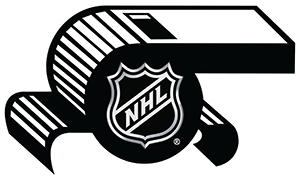History of the NHLOA
The National Hockey League Officials’ Association (NHLOA) was founded in 1969 out of a need to improve the working conditions, salaries, and benefits of National Hockey League officials. All members are active officials under contract with the NHL, working in both the NHL and designated minor leagues.
Bill Friday was the first President of the NHLOA and played a key role in its formation. The arrival of a rival professional hockey league in 1972 gave officials new leverage in their negotiations with the NHL, ultimately leading to the first Collective Bargaining Agreement (CBA) before the start of the 1973–74 season.
Over the following years, Matt Pavelich, Wally Harris, Bryan Lewis, and the late John McCauley each served as President for various terms until the 1980–81 season.
With the merger of the WHA and NHL, four WHA teams — and several of their officials — joined the NHL ranks. Dave Newell became President in 1981, serving the longest single term in NHLOA history until 1988.
The 1988 playoffs proved to be a pivotal moment for the Association. After a heated incident between a referee and the New Jersey Devils’ coach led to a one-game suspension, the team obtained a court injunction allowing their coach to return behind the bench. In protest of the league’s failure to uphold the suspension, NHL officials refused to work the next game. The contest went ahead with minor officials serving as referees and linesmen. Despite threats of fines and termination, the NHLOA members stood united — a defining moment in the Association’s fight for fairness and respect.
In the late 1980s and early 1990s, professional sports experienced an unprecedented economic boom, and player salaries soared. However, NHL officials were left behind.
In the fall of 1989, Terry Gregson became the NHLOA’s seventh President. By the summer of 1992, the Association enlisted player agent Don Meehan to help lead negotiations for their next CBA. After months of slow progress through training camp, exhibition play, and the start of the 1993–94 season, the NHLOA convened a special meeting in Toronto in November 1993 — where members unanimously voted to strike.
The NHL pressed on with replacement officials, but the effort quickly faltered. Top officials from other leagues — including the CAHA, USA Hockey, Major Junior, College, and various minor professional leagues — refused to cross the line, standing in solidarity with their NHL counterparts. This unity was instrumental in securing a successful outcome.
After a 17-day strike, the two sides reached an agreement on a new and improved CBA, featuring significant gains in severance, pension, retirement, and playoff compensation.
In 1994, Kevin Collins became the first linesman to serve as NHLOA President. He was succeeded by Andy Van Hellemond in 1995–96, followed by the return of Terry Gregson in 1996. In 2000, the Association transitioned to a new Executive Board structure.
The introduction of the two-referee system in 1999 expanded the NHLOA’s membership to 76 officials, creating opportunities for younger officials to learn from experienced veterans and easing the transition to the new format.
The year 2001 brought global challenges that far overshadowed labor matters. Following the tragic events of September 11, the start of the NHL season was marked by grief and uncertainty. Before training camp, members unanimously ratified a new CBA between the NHLOA and the NHL, reaffirming unity and stability during a difficult time.
However, the aftermath of 9/11 posed logistical challenges. Delays in processing work visas for Canadian members meant U.S.-based officials worked more than 80% of preseason games, putting their physical endurance to the test — a challenge they met with professionalism and commitment. Heightened airport security also made travel more demanding, but officials adapted quickly, keeping the game moving while honoring the memory of those lost in the tragedy.
Throughout its history, the NHLOA has been guided by countless dedicated officials who have worked tirelessly alongside its presidents and executive members to ensure the Association runs smoothly. Though too many to name here, their contributions have been — and always will be — deeply appreciated.
In the years since, the NHLOA has continued to evolve and strengthen its position. As of the 2025 – 26 season the Association comprises 35 full-time referees and 35 full-time linespersons in the NHL, plus nine minor-league referees and four minor-league linespersons who split time between the NHL and the AHL.
Throughout this period the NHLOA has maintained its commitment to professionalism, integrity and the welfare of its members by negotiating and implementing enhancements in pay, pension, travel, workload management and game-assignment standards. The Association has also embraced younger talent and ushered in new members while celebrating milestones of its veteran officials. Looking ahead, the NHLOA remains focused on meeting the challenges of a busy global hockey calendar, evolving technology in game-operations and maintaining the highest standards of officiating in the modern era.
